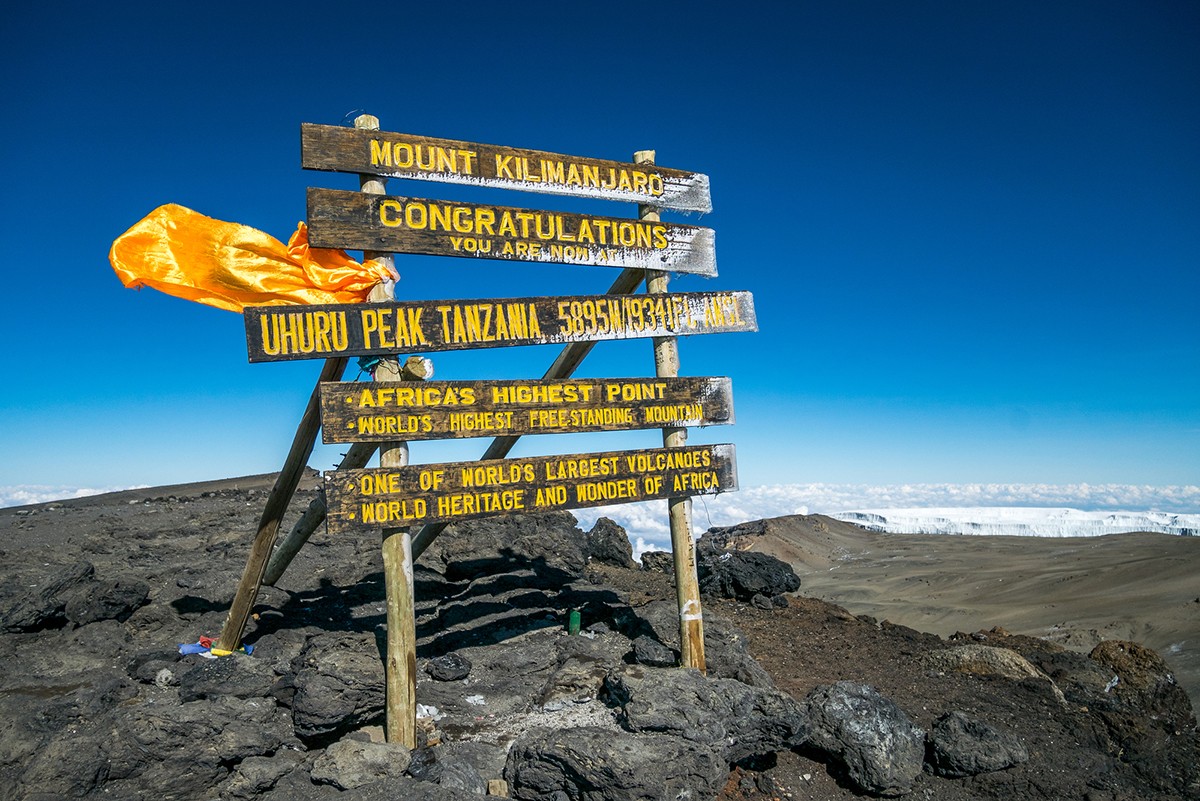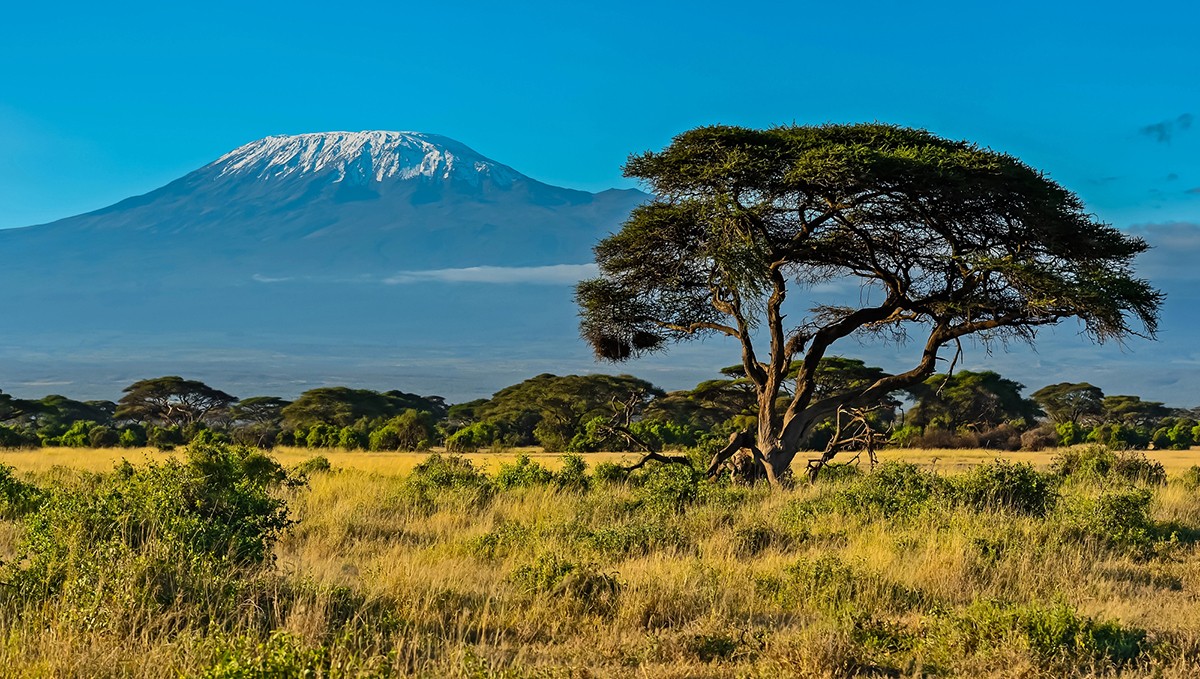Soaring to 5,895 meters, Mount Kilimanjaro is not only Africa’s tallest peak but also the world’s highest free-standing mountain.
Located in northeastern Tanzania, this iconic summit draws thousands of travellers from across the globe each year – eager to conquer its heights and witness the stunning vistas from above the clouds.
Being one of the seven summits, Kilimanjaro is a bucket-list adventure that promises both rigorous physical demands and profound personal rewards!
In this guide, we’ll put together all you need to know about hiking Kilimanjaro in Africa.
Geography of Mount Kilimanjaro
Mount Kilimanjaro, a dormant stratovolcano, is a commanding geographic landmark in northeastern Tanzania, near the Kenyan border.
This mountain is not only significant for its height but also for its geological composition, featuring three distinct volcanic cones: Kibo, Mawenzi, and Shira.
Of these, Kibo is home to the highest peak, Uhuru, which is the ultimate target for climbers.
The area surrounding Kilimanjaro is a stunning mosaic of agricultural lands, where local communities cultivate coffee, bananas and other crops, creating a lush, green foothold at the base of the mountain.
This region benefits from the fertile volcanic soil, which supports both farming and the natural flora of the lower slopes.
Climbers ascending Kilimanjaro pass through a series of ecological zones.
Starting in the cultivated lower slopes, the journey leads through montane forest, heath and moorland, and finally alpine desert – before reaching the icy summit.
Each zone is distinct in its climate, wildlife, and vegetation, offering climbers a sense of travelling from one world to another as they approach the summit.
How to travel to Mount Kilimanjaro

Travelling to Mount Kilimanjaro begins with a domestic or international flight to Kilimanjaro International Airport (JRO). Direct flights depart from Doha in Qatar, or you could hop on a domestic flight from Dar Es Salam, Tanazania’s capital.
This airport is the primary access point for climbers and is conveniently located between the towns of Moshi and Arusha – the main bases for trekking expeditions.
Once you arrive, transportation options to Moshi or Arusha are readily available – your trekking company should help you with these.
Visas on arrival are available for many countries – check your government website ahead of time – and check here for recommended vaccinations.
Which route to take

Choosing the right route for your Kilimanjaro climb is crucial to your experience and success on the mountain – you can often select from a tour of each.
Here are descriptions of three popular routes that cater to diverse preferences and skill levels:
Marangu Route
Often referred to as the “Coca-Cola” route, the Marangu route is favored for its relative ease and shorter duration, typically taking five to six days to complete.
This is the only route that offers hut accommodations so you don’t need to camp.
The ascent and descent are via the same path, making it a less scenic option than others.
However, its gradual slopes and direct approach make it a popular choice for those seeking a less strenuous climb.
That said, you may struggle to acclimatize more, and less people actually end up summiting from this route because some get altitude sickness!
Machame Route
Dubbed the “Whiskey” route, the Machame route is more challenging than Marangu and is known for its steeper trails and longer trekking days.
This route typically takes six to seven days and is celebrated for its scenic variety, offering climbers stunning views of the Shira Plateau, Barranco Wall, and Karanga Valley.
Unlike Marangu, Machame involves camping, which requires climbers to be prepared for nights under canvas.
This route is recommended for those with previous hiking experience and a strong desire to experience Kilimanjaro’s diverse environments up close.
Lemosho Route
The Lemosho route is renowned for its beauty, remote start point, and higher success rates in summit attempts.
It starts on the western side of Kilimanjaro and spans seven to eight days, giving climbers ample time to acclimatize and enjoy the breathtaking landscapes.
The route crosses the Shira Plateau, then joins the Machame route at the Shira Camp.
Lemosho offers the best of both worlds: scenic beauty and a strategic approach to altitude gain.
This makes it an excellent choice for serious trekkers who are in good shape and eager to take a longer, more immersive journey.
Cost of climbing Mount Kilimanjaro

The cost of climbing Mount Kilimanjaro can vary significantly based on the route chosen, the season, and the level of comfort desired during the trek.
Generally, climbers can expect to spend between $2,000 and $2,300 per person for a standard climb.
This section breaks down what this price typically includes and provides insight into additional costs that might arise.
Included in the Cost
- Park Fees: A significant portion of the cost goes towards park fees, which include conservation fees, camping/hut fees, and rescue fees. These are mandatory and collected by the Kilimanjaro National Park Authority.
- Guide and Porter Fees: Experienced guides and porters are essential for a successful summit attempt. Their fees are included in the package and cover their wages, insurance, and tips.
- Accommodation: Depending on the route, accommodation could be in mountain huts or camping tents. These are pre-arranged and set up by the trekking crew.
- Meals and Water: All meals during the trek are included, along with water. Special dietary requirements can usually be accommodated with prior notice.
- Transport: Round-trip transfers between Kilimanjaro International Airport and your accommodation in Moshi or Arusha, as well as to the starting point of your climb.
Additional Costs
- Gear Rental: While personal gear is recommended, items such as sleeping bags, insulated jackets, and trekking poles can be rented locally.
- Extra Nights: Additional nights in local hotels before and after the trek are not typically included but may be necessary depending on your travel plans.
- Personal Expenses: Spending money for souvenirs, extra snacks, or additional services like battery charging, which is often available at a fee in the camps.
- Travel Insurance: It is highly recommended to have travel insurance that covers high-altitude trekking up to 6,000 meters.
Tips for Porters and Guides
Tipping is customary and an important part of the income for guides and porters. A general guideline is approximately 10% of the total trip cost, distributed according to the size of the team and the duration of the trek.
Booking your Kilimanjaro trek
When booking your expedition to Mount Kilimanjaro, Altezza Travel is an African Safari company known for organizing high-quality tours in Tanzania.
Altezza offers treks up Kilimanjaro every 2-3 days, allowing for flexibility in your travel schedule.
Located directly on the slopes in the Machame area near Moshi town, their operations office is ideally positioned to manage hiking and safari adventures effectively.
Altezza Travel doesn’t just limit your adventure to the mountains.
They also offer wildlife safaris in Tanzania’s renowned national parks and relaxing beach vacations on the picturesque island of Zanzibar.
With consistently positive reviews on TripAdvisor and recognition as a leading outfitter, responsible for 15% of all Kilimanjaro climbs, Altezza Travel is your go-to for an exceptional Tanzanian adventure.
Are you ready to hike Kilimanjaro?
There’s a reason why Kili is a bucket list check for so many people! Hopefully, this guide has demonstrated how you can

